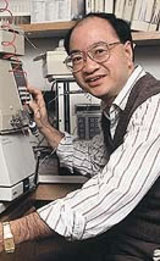This is a special edition of Rice Science, because the researcher in question today, Ka Yiu San, is a Rice "lifer," and actually got his B.S. in 1978, the year after I got my B.A.
After doing his graduate work at CalTech, Dr. San returned to campus, where he is now a professor of bioengineering, and a student advisor. (Note to undergraduates: he also teaches bioengineering fundamentals.)
Dr. San’s current work, described in a paper at Biotechnology Progress, involved inserting a gene inside a backterium, which was then used to infect the roots of a periwinkle plant. The roots could be cultured for new copies of desired proteins.
What this means in practice is we could literally grow drugs, food flavorings, or other commercial products we must now create in chemical labs.
Dr. San calls what he is doing "metabolic engineering," the application of engineering design design and analysis to the metabolic properties of cells.
The same processes which can be used to create chemicals, using these
processes, can also be used to degrade chemicals, implying that
specially-designed cells could essentially "eat" pollutants, then die
when they run out of "food."
It’s amazing stuff, and continues a Rice trend of going back-and-forth
between biological and chemical processes. And it means we can use
greenhouses where we once had smokestacks, producing many of the same
substances.










